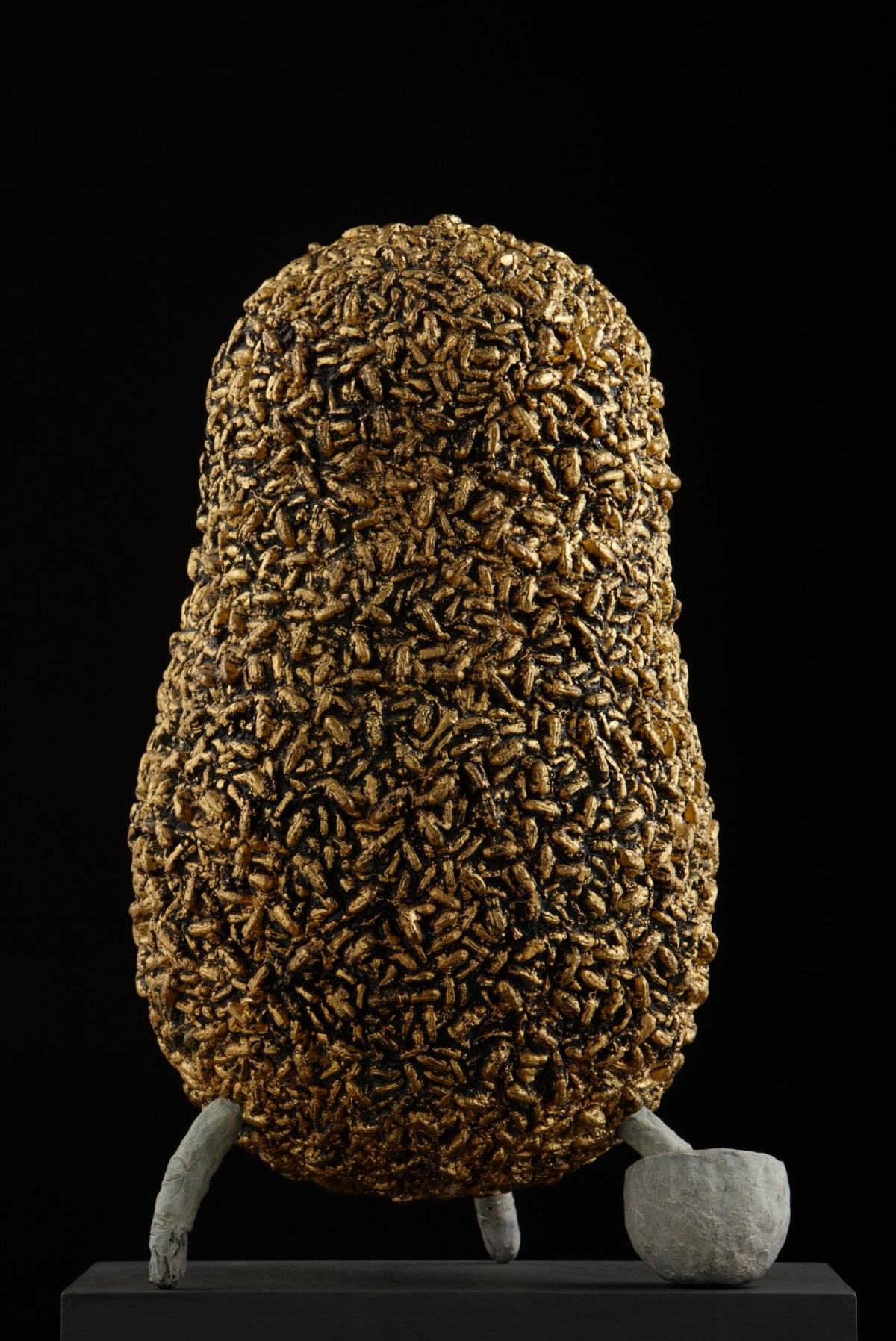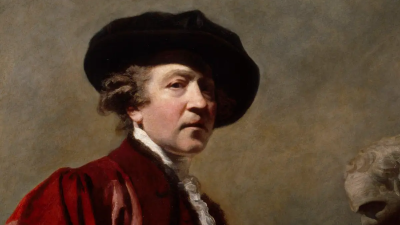
Bill Woodrow RA, Fingerswarm, 2000.
Bronze with gold leaf. 580 mm x 350 mm x 310 mm. © Bill Woodrow RA. © Photo: Royal Academy of Arts, London. Photographer: Paul Highnam.
This image is not available to download. To licence this image for commercial purposes, contact our Picture Library at picturelibrary@royalacademy.org.uk
Fingerswarm, 2000
Bill Woodrow RA (b. 1948)
RA Collection: Art
On free display in Dame Jillian Sackler Sculpture Gallery
Bill Woodrow has balanced a swarm of golden bees on three fingers. He once attended a weekend beekeeping course where the instructor dropped a swarm of bees onto his bare arm. He said: “It was an amazing experience because this large swarm just hung on my hand. It wasn't in any way dangerous or aggressive because the bees were just interested to be around the queen in the middle of the swarm and nothing else. It was incredibly light and there was this slight movement that you could just feel on your skin and there was this constant temperature. It was a very light, delicate touch.”
The swarm stands on three fingers. Woodrow explains why, “Once cast into bronze, I had this small compact swarm in a pear shape and didn't quite know what to do with it. I wanted to support it off the ground and that’s when I started thinking about the swarm on my hand because it was about the same size. From hand came fingers and three fingers sticking out like legs to support this swarm was an image that excited me. It was bizarre and slightly surrealistic. The fingers are saying there is something else inside the swarm - three hands. The fingers are supporting and pointing at the same time.” Woodrow placed one of the three fingers in a pot of wax to reflect the two-way relationship between humans and bees. As Woodrow says, “The wax is sort of a substitute for the produce of this hive. If honey was as stable as wax, I possibly would have used it. Wax is also a natural produce of the hive. It's to do with that symbiotic relationship. We look after the bees, supply them with a shelter and support, and in return for this we farm some of their produce… The hand is both supporting and taking - it's a two-way thing.”
The title is a pun that can mean “finger-swarm” referring to the three fingers, or “fingers-warm” alluding to the heat of the bees and the honey on the fingers. Woodrow describes the appeal of beekeeping: “This theme covered things that I was interested in: systems, biology, zoology, animals, insects, the natural world, and was conceptually very interesting and visually very rich.” Julia Kelly and Jon Wood observe, “Beekeeping chimed with Woodrow's sculptural imagination perfectly, since it involved the human support of, and intervention into, natural systems, the rural and urban simultaneously, and the ecological ramifications of the handling of natural objects and produce... full of narrative and allegorical scope.” (Kelly and Wood, 2013, p169) They also draw a parallel with Joseph Beuys: “For Joseph Beuys, honey and wax were symbolic sculptural materials... [He] once stated that what interested him about bees and their hive was ‘the total heat organisation of such an organism, and the sculpturally finished forms within this organisation’.” (Kelly and Wood, 2013, p168)
Technique
Woodrow sets out the stages of the making process, “It is actually quite complicated in terms of moulding and casting to make a solid form with a surface of bees on it. I first made the basic shape, then covered that with approximately half an inch of plasticine, so I ended up with a form that was slightly bigger than the final one I wanted. Then I made a piece-mould of that form. I lined the mould pieces with plasticine. And then I carved an individual bee out of a small block of car body filler and fixed it onto a little stick so that I could easily hold it. I impressed this bee into the plasticine lining the mould, many hundreds, thousands of times. So, then the plasticine was covered with the negative forms of the bees, layer on layer, building up the negative image of a complete swarm. A positive plaster swarm was made from this mould. To make the bronze version… a mould of the plaster swarm has to be made in order to make a wax version... This wax version is then used in the traditional lost-wax method to make a bronze version. The fingers are bronze, but they are cast separately and added later, as well as the small pot. Then the whole thing is put together and painted and gilded. The very last thing is the molten wax, poured into the small pot so that it just covers the tip of the finger and takes up a level. Because the pot is never totally upright, it’s just slightly off.”
Related works
Fingerswarm is from Bill Woodrow's Beekeeper series, which he began c1996. The first cast of Fingerswarm was included in the V&A exhibition Close Encounters of the Art Kind, in which works of art were lent to people in their homes. The RA's work is probably the second cast.
Further reading
Bill Woodrow: The Beekeeper, exh cat, Glynn Vivian Art Gallery, Swansea, 2002
Julia Kelly and Jon Wood, The Sculpture of Bill Woodrow, Farnham: Lund Humphries, 2013
Object details
580 mm x 350 mm x 310 mm
Start exploring the RA Collection
- Explore art works, paint-smeared palettes, scribbled letters and more...
- Artists and architects have run the RA for 250 years.
Our Collection is a record of them.



